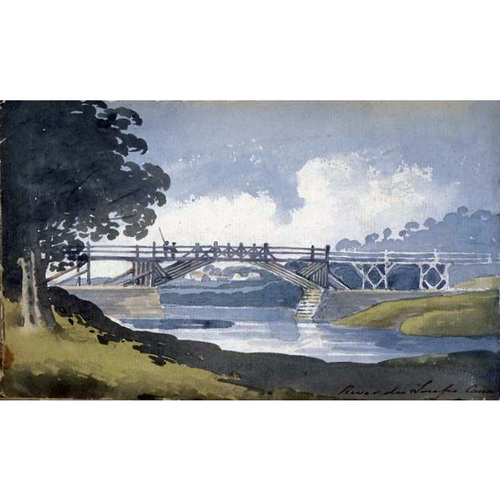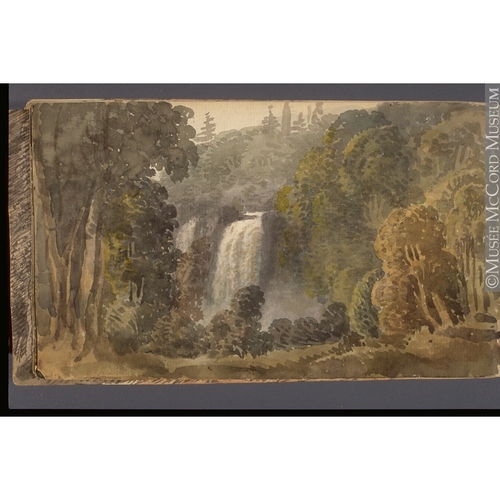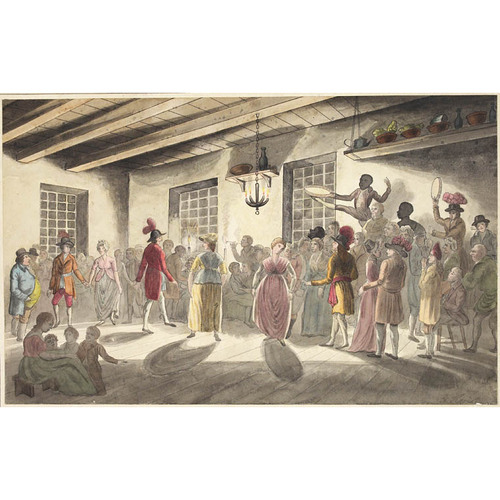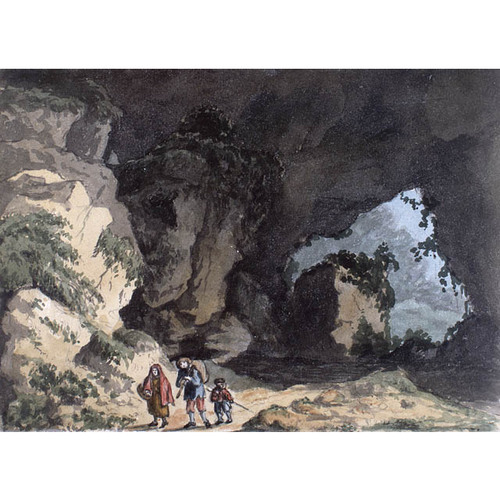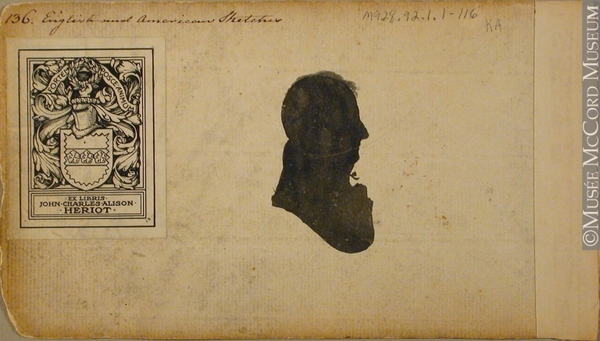
Source: Link
HERIOT, GEORGE, office holder, landscape artist, and author; b. 1759 in Haddington, Scotland, eldest of four children of John Heriot, sheriff clerk of Haddington, and Marjory Heriot; d. unmarried 22 July 1839 in London.
As a member of the Scottish minor gentry, George Heriot received a sound classical education. He appears to have initially attended the Duns Academy and the grammar school at Coldstream. Subsequently he studied at the Royal High School, Edinburgh, from 1769 to 1774, under two eminent classical masters, Luke Fraser and Alexander Adam.
Between 1774 and 1777 Heriot seems to have resided in Edinburgh, where he most likely received instruction in drawing and painting. He was befriended by that Scottish Maecenas, Sir James Grant, who encouraged him to pursue a career in art. In 1777 Heriot left for London planning to take up this vocation, but for some inscrutable reason did not; instead he sailed to the West Indies. During four years there he made many notes and sketches of the life and landscape of the islands and composed a poem based on his experiences. A descriptive poem, written in the West Indies was published on his return to Britain in 1781.
Back in Britain, Heriot enrolled as an officer cadet at the Royal Military Academy, Woolwich (London), where he was given instruction by the academy’s chief drawing master, the eminent topographical artist Paul Sandby. Officer cadets were trained in landscape drawing, valuable in the field for the planning and execution of strategy and for the recording of troop movements and deployment. It was perhaps also under the tutelage of Sandby that Heriot was introduced to the concept of the Picturesque, that connoisseurship of scenery wherein nature is examined in terms of art. The essential characteristics of the Picturesque in nature as in painting are irregularity of form and balanced compositions. Subjects chosen to convey these characteristics are often localized and rural; the style is present in Heriot’s water-colours and sketches of the mid to late 1780s and in a series of etched picturesque views of the Channel Islands which he published in 1789–90. Indeed, evidence of the Picturesque was to survive in Heriot’s art until the end of his career.
By about 1783 Heriot was no longer formally associated with the Royal Military Academy, although he continued to live and work in Woolwich, as a civilian clerk attached to the Board of Ordnance, and to make sketches there as well as in the Channel Islands and locations in southern England. In 1792 he was posted to Quebec and promoted clerk of the cheque in the Ordnance department. Heriot was to remain in Lower Canada until 1816, except, apparently, for two periods of absence, in 1796–97 and in 1806. His first years at Quebec are not well documented. Sketches record visits in and about Quebec and Montreal, perhaps on Ordnance business. In November 1792 he published a sketch of Jersey in the Quebec Magazine and the following year he prepared a view of Quebec, perhaps also intended for publication. When he returned to Britain in 1796 he resided in London, travelled to the south coast, and made at least one sketching foray into Wales. From the autumn until Christmas he was enrolled at the University of Edinburgh. He then returned to London. A watercolour prepared from his sketches of Wales and two Canadian views were accepted by the Royal Academy of Arts for exhibition in the spring. Heriot probably sailed for Lower Canada soon afterwards, taking notes and making sketches on the voyage.
The impact of his visit to Britain was considerable. While there he had been stimulated by the art he had seen and by his success as an artist. He returned with a fresh enthusiasm for the Canadas; he began to read about their past and to make elaborate notes and numerous sketches of the places he visited and the peoples he encountered. His sojourn abroad had affected his artistic vision of the Canadas; his drawings and water-colours assumed a new confidence and his landscape forms developed a new strength and grandeur. In London he had probably studied the simply handled and remarkably strong water-colours of younger British artists such as Thomas Girtin, Joseph Mallord William Turner, and John Varley. Either in Britain or in Lower Canada he had also become familiar with Lieutenant George Bulteel Fisher*’s Six views of North America . . . (London, 1796). He was influenced by this work, especially by Fisher’s use of the Picturesque in depicting Canadian landscape.
The visit to Britain apparently benefited Heriot still further. In 1797, through the influence of his brother John, a prominent Tory newspaper editor there, he added to his post as clerk of the cheque the more senior position of assistant storekeeper general, under John Craigie*. Two years later, on learning that Heriot held both offices and received two salaries, the commander-in-chief of the forces in British North America, Prince Edward* Augustus, removed him from the senior post. While in Britain, however, Heriot had met, again through his brother’s connections, Prime Minister William Pitt, and in 1799 Pitt recommended him for the position of deputy postmaster general of British North America when it became vacant on the removal of Hugh Finlay*. Heriot was appointed on 18 Oct. 1799.
The office of deputy postmaster general, which Heriot assumed at Quebec the following April, at first seemed well suited to his talents. In his Ordnance post, which he did not relinquish, he had proved himself a capable administrator; now he worked hard to establish the mails on a better footing. His predecessor had begun twice-weekly service between Montreal and Quebec, but east and west of those centres, on poor roads which passed through sparsely settled countryside, service was much slower. Heriot embarked on an ambitious program of improving the mails between Quebec and Halifax, as well as through Upper Canada. His initial enthusiasm was dampened by the inflexibility of postal regulations and by the lack of interest and understanding of the postmaster general in London, to whom he was directly responsible. Regulations required that any postal service be self-supporting, that expenses incurred in expanding or improving a service be justified by a corresponding increase in revenue, and that all profits be forwarded to the postmaster general in London. Thus, Heriot’s scheme of using excess revenue from the more populated parts of Upper Canada to finance improvements in service to the isolated but rapidly expanding southwestern section of the province was blocked by his superiors in London. He did, however, receive aid from the lieutenant governor, Peter Hunter*, who was anxious to improve communications within the province. To put into effect his proposals for more frequent service, he made in 1801 the first of several trips to Niagara (Niagara-on-the-Lake). His plans were not entirely successful, but by 1805 he had managed to increase winter service to Niagara from one delivery during the entire season to one delivery per month, and additional couriers were placed on the Montreal–Kingston route.
His posts in the Ordnance and the Post Office brought him into contact with the military and administrative élite of Lower Canada. He was probably a friend of Lieutenant-Colonel John Nairne*, whose seigneury at Murray Bay he had visited as early as 1798, and he was on close terms with his cousin Frederick George Heriot, a British army officer. In 1807, at least, he was a member of Quebec’s exclusive Barons’ Club, composed of prominent administrators and merchants such as Herman Witsius Ryland and George Hamilton.
Heriot’s first years as deputy postmaster general were difficult ones, but he found solace in writing. As a result of his interest in Lower Canada’s past, he published in London in 1804 The history of Canada, from its first discovery. Based largely on Histoire et description générale de la Nouvelle France . . . (3v., Paris, 1744) by Pierre-François-Xavier de Charlevoix*, the work was one of the first histories of Lower Canada published in English. Like Charlevoix’s work, it ended in 1731. Although he had envisaged more than one volume, Heriot never published a second.
Heriot seems to have enjoyed his travelling. Improvement of postal facilities took him on frequent journeys between Quebec and Montreal and in 1807 he visited New Brunswick and Nova Scotia. That trip resulted in a warm and lasting friendship with judge Edward Winslow*. His travels provided him with the opportunity to make notes and sketches of the country and of the inhabitants he met. So rich a collection of material, both notes and sketches, did he amass that he decided to write a book about his journeys illustrated with his own views and figure studies. In 1807 in London he published his well-known Travels through the Canadas. The first part of the book is largely a topographical description of the towns and settlements he had visited or read about, from Newfoundland to Lake Superior, with particular attention paid to picturesque geographical features, especially Niagara Falls which “surpass in sublimity every description . . . the powers of language can afford.” The second half, highly derivative, describes the manners and customs of various Indian nations. Yet Travels is significant within the Canadian context. It is one of the earliest books to describe the Canadian landscape largely from the point of view of the Picturesque.
Although his writing and sketching provided him with pleasant relaxation, Heriot had been constantly plagued by problems with the post caused by a growing population. Not only did mail regulations frustrate his plans for improving deliveries and opening new routes, but he had difficulties with the administration at Quebec. He lacked tact and diplomacy, was strong-willed, and displayed an exaggerated sense of self-importance. The combination proved to be unfortunate: his attempts to gain the cooperation of the colonial government often ended in failure. Late in 1801, within days of Finlay’s death, Heriot wrote to Sir Robert Shore Milnes, lieutenant governor of Lower Canada, requesting two posts held by his predecessor. Heriot probably considered them not only his due, but necessary for the smooth functioning of the postal system. A seat on the Legislative Council would lend him the government’s ear, and the appointment as superintendent of post houses would enable him to control the transportation and lodging on which the postal couriers were dependent. He obtained neither. Milnes defended his choice of Gabriel-Elzéar Taschereau* as superintendent to the colonial secretary and added criticisms concerning Heriot’s character and lack of qualifications. Relations between Heriot and the lieutenant governor began to deteriorate. In 1805 Heriot was asked by Milnes to accept, after hours, dispatches for delivery to a ship anchored in the Quebec harbour; he refused. When Milnes sent a stinging rebuke, Heriot wrote back in a less than conciliatory tone: “I consider the sending [of] papers to me without any written request . . . as highly disrespectful, and that I am by no means officially obliged to cause any Letters or dispatches to be sent on board of Vessels.” Outbursts of this sort created resentment among colonial officialdom that increased as the years passed and resulted in complaints being lodged against Heriot in London.
In 1806 Heriot returned to Britain, probably on family business. The next year, back in Quebec, he faced mounting criticism from the business community in the colonies concerning the slowness of the mails. Problems escalated during the War of 1812. The colonial administration began to make demands on him and his service which he felt were excessive and in certain cases unjustified. In 1813 he wrote to the postmaster general complaining that the governor, Sir George Prevost*, was meddling: “He has made it a practice to interfere with the Post Office, as if that Department were solely under his Controul.” Prevost’s conduct was “unlike any that I have ever before experienced.” Attending this difficulty was Heriot’s increased responsibility, which did not diminish with the ending of hostilities. As a result, he found fewer opportunities for “cultivating society.” In 1815 he wrote to the postmaster general of the growing burden of work associated with his established duties and the addition of new responsibilities, which now included the superintendence of postmasters and couriers, the examination of the various post office accounts, the writing of the controllers’ sheets (originals and duplicates), and the payment of employees. His request for a raise in salary was refused; word had reached London concerning the difficulties which Heriot was causing the colonial administration.
Heriot’s request for an increased salary had likely also been prompted by the fact that he had lost his Ordnance post as clerk of survey, to which he had been promoted in 1804. In 1813 a member of the Board of Ordnance with whom he had quarrelled earlier took his revenge. He ordered Heriot to Kingston, knowing that his responsibilities as deputy postmaster general necessitated his presence at Quebec. When Heriot refused to take up the Kingston post he was suspended from the service.
In 1815, after a visit to New York and Washington to discuss the restoration of postal deliveries from Britain through the United States, Heriot began to contemplate resignation. The decision was precipitated by the harassment of Sir Gordon Drummond*, administrator of Lower Canada, who in a letter to Heriot at the end of October insisted that he immediately carry out some postal reforms. Heriot replied but he did not answer Drummond’s lengthy questions. Drummond sent a fiery missive to London complaining of the deputy postmaster’s unconscionable behaviour. Although Heriot considered travelling to England to explain his administrative problems to the postmaster general, in January 1816 he decided instead to resign. The following summer he sailed from Quebec for England, knowing that he had seen the Canadas for the last time. After his return to Britain, Heriot made frequent trips abroad – visiting France, Italy, Austria, Spain, and Germany. In 1824 he published two numbers of an illustrated travel book. Entitled A picturesque tour made in the years 1817 and 1820, through the Pyrenean Mountains, it was to be his last work. He continued to travel and to sketch – indeed, almost until the last year of his life. He died in London in July 1839, the cause of death being indicated as “decay of nature.”
Two other British topographical artists working in Canada whose backgrounds were similar to Heriot’s were Thomas Davies* and James Pattison Cockburn. Their landscape water-colours of Canada, like those by Heriot, were painted mainly in leisure hours and were kept as attractive reminders of the places they had visited. Cockburn enjoyed recording the urban scene; Davies, like Heriot, showed a preference for the countryside and outlying settlements, although both were attracted to the grandeur of Canada’s rivers and forests.
Heriot’s significance is threefold: as an energetic office holder, as a writer, and most important, as an artist. As deputy postmaster general he began an ambitious program of improving deliveries and increasing postal stations from Halifax to Sandwich (Windsor). His attempts to create a better service were a mixed success. Postal regulations fettered him and attempts to gain the cooperation of the colonial administration often failed, largely owing to his abrasive personality. As a writer, he made a contribution to the early travel literature of Canada. As a colonial landscape artist, he is more significant. His water-colours and drawings (which received no serious attention until the beginning of the 20th century) are supremely attractive works of art, often felicitously coloured and sometimes quite precisely detailed. As unconscious social documents they are invaluable. They provide eloquent witness to a life and landscape long since gone. On another level of significance they mirror the culture and skill often associated with those many-selved individuals whom 18th-century Britain cultivated and from whom the colonial service and settlements greatly benefited.
A detailed list of George Heriot’s water-colours, oil paintings, sketch-books, and engravings can be found in a biography of him by G. [E.] Finley, George Heriot, postmaster-painter of the Canadas (Toronto, 1983). Heriot is the author of A descriptive poem, written in the West Indies (London, 1781); The history of Canada, from its first discovery, comprehending an account of the original establishment of the colony of Louisiana (London, 1804); Travels through the Canadas . . . (London, 1807; repr. with intro. Toronto, 1971); and A picturesque tour made in the years 1817 and 1820, through the Pyrenean Mountains, Auvergne, the departments of High and Low Alps, and in part of Spain (London, 1824), of which only two parts were published.
GRO (London), Death certificate, George Heriot, 22 July 1839. Library of Congress, ms Division (Washington), Caldwell Woodruff, “Family of Heriot of Castlemains, Dirleton, Haddington, Scotland . . .” (typescript, Baltimore, Md., 1918). PAC, RG 8, I (C ser.), 284, 1219. PRO, CO 42/121, 42/128, 42/140, 42/144, 42/146, 42/163. Univ. of Edinburgh Library, Special Coll. Dept., Matriculation records. Edinburgh Rev. (Edinburgh and London), 12 (1808–9): 212–25. G. E. Finley, George Heriot (Ottawa, 1979); George Heriot, painter of the Canadas (Kingston, Ont., 1978). William Smith, The history of the Post Office in British North America, 1639–1870 (Cambridge, Eng., 1920; repr. New York, 1973). Jean Bruchési, “George Heriot, peintre, historien et maître de poste,” Cahiers des Dix, 10 (1945): 190–205. J. C. A. Heriot, “George Heriot,” Canadian Antiquarian and Numismatic Journal, 3rd ser., 7 (1910): 101–5.
Cite This Article
Gerald E. Finley, “HERIOT, GEORGE,” in Dictionary of Canadian Biography, vol. 7, University of Toronto/Université Laval, 2003–, accessed December 31, 2025, https://www.biographi.ca/en/bio/heriot_george_7E.html.
The citation above shows the format for footnotes and endnotes according to the Chicago manual of style (16th edition). Information to be used in other citation formats:
| Permalink: | https://www.biographi.ca/en/bio/heriot_george_7E.html |
| Author of Article: | Gerald E. Finley |
| Title of Article: | HERIOT, GEORGE |
| Publication Name: | Dictionary of Canadian Biography, vol. 7 |
| Publisher: | University of Toronto/Université Laval |
| Year of publication: | 1988 |
| Year of revision: | 1988 |
| Access Date: | December 31, 2025 |




